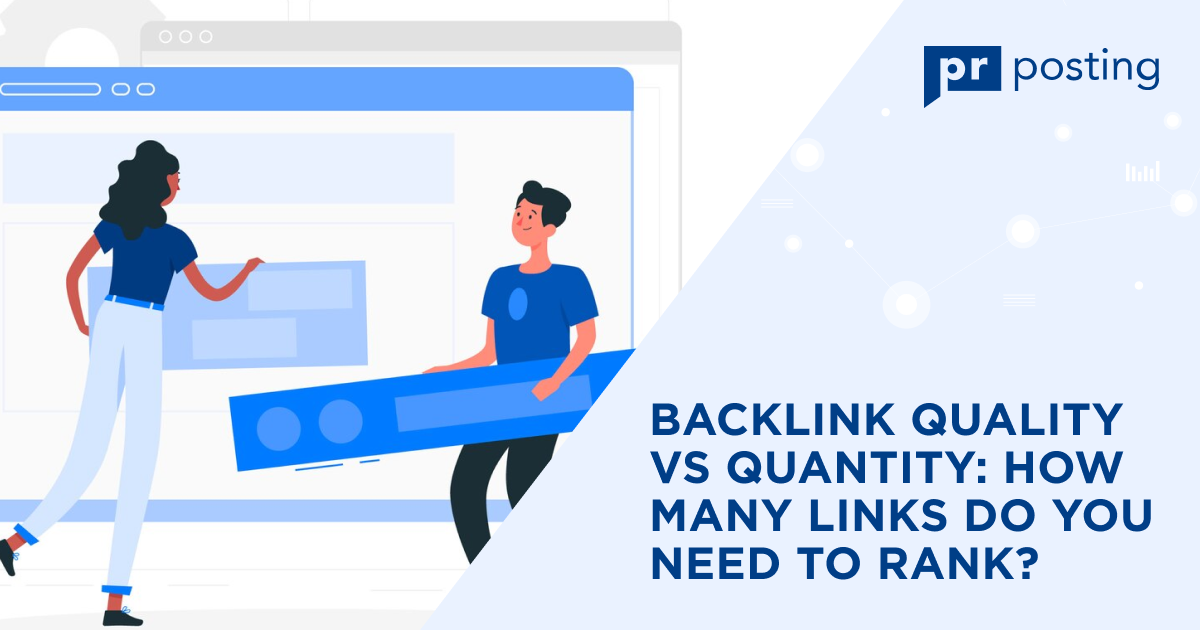Backlink Quality vs Quantity: How Many Links Do You Need to Rank?

Quality links boost trust even more than just numbers. Quantity alone does not guarantee better rankings, so you should aim for authoritative, applicable backlinks instead of many bad ones. This article explains how to balance link quality and quantity to improve search results.
A good number of backlinks varies depending on the industry and competition. Analyzing competitors and using tools to determine Google ranking can guide your strategy. Prioritize creating high quality backlinks to ensure sustainable SEO results.
Why Backlinks Are Important for SEO
How Backlinks Influence Domain Authority (DA) and Domain Rating (DR)
Backlinks are the strength of a website on the Internet. They affect domain authority (DA) and domain rating (DR), which measure trustworthiness.
DA Predicts how well a site is likely to rank in search results. DR Evaluates the number and strength of referring domains. Additional high-quality backlinks improve both scores. Stronger scores mean better ranking potential.
Backlink Quality Score and Its Impact on Rankings
Not all backlinks carry the same weight. Google evaluates the quality of links to score them:
- Relevance. Links from affiliated content improve relevance and SEO value.
- Authority. Authoritative sources provide better link value.
- Placement. Links within content are more important than those in footers.
- Anchor Text. Descriptive anchor text boosts the effectiveness of links.
High-quality backlinks signal trustworthiness and expertise. Poor-quality links from unrelated or spam sites harm rankings. A robust backlink strategy that works involves harmonious evaluation.
Monitoring Backlink Quality and Quantity for SEO
Regularly review backlinks to maintain a strong profile. Use technical tools to track link health and performance:
- Check the number of backlinks compared to your competitors;
- Identify “toxic” links that may need disavowing;
- Optimize anchor text distribution for varied link contexts.
Quality and relevance outweigh pure volume. Prioritize creating high quality backlinks over numerous weak ones. A balanced approach helps build trust and authority while minimizing risks. Long-term ranking success is achieved through effective management of link quantity and quality.
Factors That Influence Your Backlink Needs
Website Niche and Competition
The industry you are in determines backlink requirements. Some sectors are highly competitive, requiring an aggressive link-building strategy. Competitive niches demand further backlinks to rank well and maintain visibility. Low-competition sectors may require smaller but mostly targeted and applicable links.
For example, finance and health industries have many links, while original service businesses need fewer backlinks. Analyze your competitors to see whether your domain has enough links. Tools that monitor backlink profiles can help identify gaps.
Target Keyword Difficulty
Keywords influence link-building efforts and determine how many backlinks are necessary:
- High-difficulty keywords need additional backlinks from authoritative and relevant sites.
- Low-difficulty keywords allow you to rank with smaller, high-quality links.
Targeting on simpler terms first creates momentum. This strategy helps gain visibility faster in preparation for further competitive terms. Consider keyword research tools to evaluate difficulty scores.
Content Quality and Relevance
Your content quality directly affects the success of your backlinks. Great content attracts organic links. Educational, engaging content attracts more natural and sustainable backlinks:
- Usable, updated content keeps the link relevant over time.
- Create practicable, relevant resources that solve readers’ problems.
- High-value content establishes authority and encourages others to link to it. Regularly updating content keeps it applicable and improves its linkability.
Domain Age and Authority
Domain history plays a critical role in backlink requirements. Established domains typically need new, smaller backlinks.
- Aged domains already have significant authority and accumulated link capital.
- Newer domains must build a strong backlink profile from scratch.
New sites should prioritize creating high quality backlinks to build trust. Focus on getting links from trusted sources relevant to your niche. Balance quality and volume to grow continuously while avoiding spam links that harm rankings. Use monitoring tools to track progress and adjust your strategy.
Many factors influence the number of backlinks your website needs to rank effectively. These include the competitiveness of your niche, the difficulty of your target keywords, the quality of your content, and the authority of your domain. A thoughtful backlink strategy balances these elements to maximize SEO gains.
Determining a Good Number of Backlinks for Your Website
Backlinks influence search engine rankings by signalling trust and authority. However, more does not always mean better. The right number of backlinks depends on many factors. Checking the number of backlinks and targeting the right keywords can significantly improve rankings.
Competitors Analyzing
Understanding your competitors’ backlink strategies helps you set realistic goals. Researching link profiles reveals patterns that contribute to success:
- Identify the main competitors in your niche;
- Use backlink analysis tools to audit their profiles;
- Compare the backlink quality vs quantity they use.
Tools like Ahrefs, SEMrush, or Moz help you explore link-building trends. They also allow you to find your rank on Google and assess where improvements are needed:
- Track the domains that link to competitors.
- Evaluate the relevance and authority of links.
- Identify gaps where your site lacks connections.
- Use analytics to upgrade your strategy and close competitive gaps.
Targeting Low-Competition Keywords
Ranking for high-volume keywords requires significant effort. Start with easier wins:
- Focus on long-tail keywords with low difficulty.
- Build high-quality SEO high-quality backlinks for these terms.
Step-by-Step Approach
- Research keyword difficulty using reliable tools.
- Optimize content for low competition terms.
- Get links from authoritative sites that are relevant to your niche.
Scaling up helps maintain growth. A thoughtful transition from easy to hard keywords saves resources and improves effectiveness.
A good number of backlinks depends on your industry and keyword competition. Analyze your competitors, start with achievable goals, and develop methodically. Combining a keyword strategy with a balanced backlink profile ensures sustainable rankings.
Types of Backlinks and Their Value
Backlinks remain one of the most important factors in SEO. However, the value of backlinks depends on several factors. Not all backlinks are created equal. Selecting the proper backlink can significantly improve your rankings.
High-Quality Backlinks vs. Low-Quality Links: Influence on SEO
High-quality backlinks come from reputable and authoritative sources. These links convey trust signals to search engines, improving your site’s authority and trustworthiness. Conversely, low-quality backlinks can have the opposite effect, lowering your rankings.
High-quality links:
- From reputable and trusted websites;
- Contextually relevant to your content;
- Earned through organic means similar to guest posts, collaborations, and media mentions.
Low-quality links:
- From low-authority or spam sites;
- Not relevant to your niche or content;
- Often purchased or manipulated, which can lead to penalties.
Search engines, like Google, prioritize backlink quality over volume. One high-quality link can be far more valuable than dozens of low-quality links.
Nofollow vs. Dofollow Backlinks
Understanding the difference between dofollow and nofollow backlinks is essential to creating a well-balanced backlink profile.
Dofollow backlinks
These are the most valuable for SEO. They convey link value, directly impacting your rankings and authority. High quality dofollow backlinks from a trusted site can provide a significant SEO boost.
Nofollow backlinks
While they do not pass link equity, nofollow links can still drive traffic to your site and enhance visibility. They help diversify your backlink profile and can support your overall SEO efforts.
Both types of links have their place, but dofollow backlinks generally have a more significant impact on your website’s rankings.
Toxic Links and Their Negative Impact on Rankings
Toxic backlinks are links that come from dangerous or low-quality sources. These links can severely damage your website’s SEO and lead to penalties from search engines. Websites with spam content, irrelevant niches, or poor reputations are often sources of toxic backlinks.
Toxic links are generally:
- From sites without domain authority;
- Not relevant to your website’s content or niche;
- Part of a link scheme or purchase.
These toxic links can lower your backlink quality score, an essential factor in your website’s ranking.
Creating High-Quality Backlinks with a Winning Strategy
A well-planned backlink strategy is essential to maintaining a strong and healthy backlink profile. Creating high authority backlinks requires thoughtful approaches and coordinated effort.
Creating a Backlink Strategy That Works
To create a backlink strategy that works, focus on organic link-building methods. Aim for a combination of high-quality backlinks that will improve your rankings and contribute to long-term SEO success.
How to Create High Quality Backlinks Using Content Marketing and Outreach
Content marketing is an important tool for attracting high-quality backlinks. Well-crafted content that provides value can earn links organically. Additionally, outreach efforts, like guest posting and influencer collaborations, help you build relationships with authoritative sites in your industry.
Prioritizing Relevance and Contextual Linking for Sustainable Growth
Focusing on applicability and contextual linking is critical for sustainable growth. Make sure that the sites linking to you are relevant to your niche and that the links appear in the right context. This ensures that the backlinks provide value to your audience and search engines.
You can maintain a strong backlink profile by constantly monitoring backlink quality and quantity.
Monitoring Backlink Quality and Quantity for SEO
Backlink quality and quantity are pivotal to SEO success. Regularly tracking your backlinks helps maintain a solid SEO strategy. Quality backlinks improve rankings, while too many low-quality links can harm your ranking.
How to Monitor Your Backlink Quality and Quantity for SEO Success
Track your backlinks to ensure they are aligned with your SEO goals.
Here is how to effectively reach out:
- Evaluate the quality of backlinks using metrics like domain authority and trustworthiness.
- Count the number of backlinks to the volume.
- Check the anchor text for relevance and context.
- Identify link sources to ensure they come from reputable sites.
This process helps identify weaknesses in your backlink strategy.
Tools for Managing and Upgrading Your Backlink Profile
Various tools can simplify the monitoring and management process:
- Ahrefs. Tracks backlink growth and evaluates link quality.
- SEMrush. Offers a comprehensive backlink audit tool.
- Moz. Provides domain authority scores and backlink analysis.
- Google Search Console. Shows all backlinks to your website.
These tools give detailed insights into your backlinks’ health and performance.
Common Backlink Mistakes and How to Avoid Them
Avoiding common mistakes can hurt your SEO efforts. The following errors can undermine your backlink strategy:
Prioritizing Quantity Over Quality
- Relying solely on the number of backlinks is a mistake.
- High-quality backlinks give more value than numerous low-quality ones. Quality backlinks improve SEO.
- Low-quality links can harm your rankings.
Ignoring Link Relevance and Context
Backlinks from irrelevant sites will not improve your SEO. Ensure that links come from content-rich, contextually applicable sources. Irrelevant backlinks reduce authority.
Relying on Outdated or Spam Link Building Techniques
Old, spammy link-building methods can damage your website. Instead, focus on ethical, sustainable strategies like content marketing and outreach.
Avoid buying backlinks or using link farms. Use organic, natural link-building practices.
Setting Backlink Goals for Different Websites
Backlink goals should be tailored to the specific needs of your website’s audience. The type of business or website you have dictates your approach. For successful SEO, it is essential to set realistic, tailored backlink objects.
Goals for Local and National Businesses
Local businesses benefit from original, authoritative backlinks. Their goal is to rank well for location-based queries.
Local businesses:
- Focus on local directories.
- Collaborate with community sites.
- Gain links from local influencers.
National businesses need a broader outreach. The goal is to get links from highly authoritative, publicly accessible sites. Monitoring backlink quality and quantity for SEO ensures your strategy remains on track.
National businesses:
- Watch for public media mentions.
- Target industry leaders.
- Build relationships with reputable websites.
Goals for Personal Blogs and Large Brands
Personal blogs usually aim to build the trust of a niche audience. Their backlink goals often focus on quality over quantity.
Personal blogs:
- Engage with niche communities.
- Build organic, content-driven backlinks.
- Target authority sites in specific niches.
Large brands are looking for a more expansive yet controlled backlink strategy. They often pursue quality and quantity.
Large brands:
- Use PR campaigns.
- Get backlinks from reputable publications.
- Build partnerships with influencers.
Integrating Backlink Data with Your Broader SEO Strategy
Backlink data should contribute to your overall SEO efforts. Use it for content creation, outreach strategies, and site optimization.
- Link data helps refine your content.
- The quality of your backlinks helps improve your domain authority.
Common Pitfalls and Solutions in Backlink Building
Many website owners make common backlink mistakes. Avoiding these can help maintain a healthy SEO profile.
Dealing with Low-Quality Links
Low-quality backlinks can hurt your rankings. It’s imperative to disavow dangerous links regularly.
Solution: Use tools to identify and remove toxic backlinks.
Action: Focus on getting organic, high-quality links.
Overcoming Slow Backlink Growth
Backlink growth may be slow at first, but patience is key.
Solution: Consistently create high-quality, shareable content.
Action: Reach out to relevant websites for backlinks.
Conclusion
Backlink building requires balance — both backlink quality and quantity matter. A strong strategy involves high-quality links from estimable sources combined with harmonious growth. To succeed, concentrate on sustainable tactics and avoid shortcuts.
Actionable steps
- Set clear backlink goals based on the type of website you have.
- Use tools to monitor, track, and improve your backlink profile.
- Avoid common pitfalls.
By following these tips, you will enhance your rankings and strengthen your SEO efforts.
FAQs
What is a high-quality backlink?
A high-quality backlink comes from an authoritative, relevant source. It passes SEO value and improves the quality score of your backlink.
How to get a high-quality backlink?
- Create valuable content.
- Participate in outreach campaigns.
- Guest posts on reputable sites.
How many high quality backlinks do I need to improve SEO?
A good number of backlinks varies. Focus on acquiring high-quality, relevant links, not quantity.
How does my website rank on Google?
Use a rank tracker or SEO tool to monitor your website’s position to find out your Google ranking.




